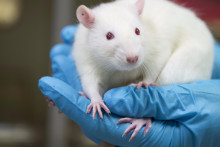‘This infrared image shows a tumor of the breast tissue in a mouse,’ says professor Prakash from the research group Advanced Bioengineering and Therapeutics. He points to an image on the computer screen where the contours of the mouse are clearly visible, while a round, colorful area indicates where the tumor is. ‘We have made the tumor visible by injecting nanoparticles that attach specifically to the so-called tumor associated macrophages. These are immune cells of the body that are ‘hijacked’ by the tumor and used for its protection.’
'The nanoparticles we use can reprogram these immune cells into cancer killers'
Different colors indicate the density of the tumor: red where most of these particles are present, and where the tumor is most dense, while the blue color towards the edges of the tumor show less dense tumor tissue. ‘Our research is aimed to reclaim and reprogram these hijacked immune cells, so they will attack the cancer cells instead of protecting it. The nanoparticles we use can reprogram these immune cells into cancer killers,’ Prakash explains. ‘In this experiment we have shown that these nanoparticles indeed reach the tumor and selectively bind to the hijacked immune cells that are present in and around the tumor tissue.’
Inactivating T-cells
The body’s immune system is a highly complex and powerful defense against invaders, like bacteria and viruses, where different organs, cells, and proteins work together. It also plays a central role in the body’s fight against cancer. Different immune cells, with specific tasks target and may destroy the tumor cells. For example, certain white blood cells, called T-cells, recognize tumor cells and kill them. They are an effective weapon against cancer. To prevent these T-cell from overreacting, potentially damaging healthy cells, normal body cells may have protective proteins on their surface. These so-called checkpoint proteins bind to the T-cells, inactivating them while preventing a lethal T-cell attack on healthy tissue. This way, the body keeps the immune response from overreacting.
However, some tumors may smartly use this system and also synthesize these proteins on their cell surface, inactivating the T-cells. As a consequence, the tumor can grow uninhibited. ‘That is why current immunotherapy is focused on blocking these checkpoint proteins, so the T-cells remain active and can better destroy tumor cells,’ Prakash explains. ‘Unfortunately, it doesn’t work for all patients, while it is mainly effective in blood cancers, like leukemia. So, we need to come up with new effective methods that can also be applied to other types of cancer.’

Hijacked macrophages
The smart use of the checkpoint proteins by cancer cells to protect themselves against the immune system is just one example how tumors may change their environment to allow for their unlimited growth. Another trick tumors may pull out of their sleeve is to ‘hijack’ other immune cells, the macrophages. Like the T-cells, these may also kill the cancer cells by ‘eating’ them. But by using chemical signals, the tumor is capable of changing these macrophages and turning them into collaborators. These tumor-associated macrophages, briefly TAMs, not only don’t fight the tumor anymore, but in addition help it to grow and spread throughout the body.
‘The tumor cells and the TAMs communicate and help each other: the TAM’s may nourish tumor cells and even protect them from chemotherapeutical treatment,’ Prakash explains. ‘They may also help the cancer to spread by stimulating the tumor to produce chemicals that prepare and change healthy tissues, for receiving tumor cells, where a new tumor will start to grow.’ Normally, the cell matrix protects the cell against tumor cell invasion. But the TAMs change this protecting network of proteins that support cells and tissues in the body, creating a so-called pre-metastatic niche, where spreading cancer cells may easily land and grow. Prakash: ‘This way of changing the environment is a common mechanism for most cancers. Therefore, our research focused on changing these TAMs back into healthy immune cells that fight the tumor.’
Sophisticated nanoparticle
In their research on how to change and cure the TAMs, Prakash and his team first had to find them. To achieve this, they created a sophisticated nanoparticle, resembling a dead cell, that the TAMs would recognize and ‘eat’. ‘The nanoparticle we created was a membrane-like double layer of phospholipids, compounds that consist of a water-soluble head and non-water-soluble tails. They easily form a double layer with the tails inside and the head sticking out,’ Prakash says. ‘We managed to modify this particle with a few tails sticking out: the TAMs recognized these tails as an invader, and reacted much more strongly to them than healthy macrophages. They subsequently ate the whole particle.’

Now the TAMs could be reached, in a next step, the scientists further modified the nanoparticle to change the TAMs back to healthy macrophages. Inside the nanoparticle, the scientists incorporated a molecule, muramyl, coming from a bacterial cell wall. Muramyl is known for stimulating the immune system by enhancing the production and release of cell-killing chemicals, the so-called cytokines. When the TAMs took up the muramyl-containing nanoparticle, they surprisingly changed their properties and started secreting cytokines, killing tumor cells, instead of helping them.
Decrease in tumor size
Mice with breast cancer treated with the new technology showed a stunning 70 percent decrease in tumor size. Using a combination with another therapy, for example radiation or chemotherapy, the tumor could be destroyed completely. And as importantly, there was no spreading of the tumor to other tissues, like the lungs. ‘We discovered that the formation of pre-metastatic niches, crucial for tumor spreading, did not happen,’ Prakash explains. ‘The cell matrix in lung tissue was completely healthy and normal.’
'We discovered that the formation of pre-metastatic niches, crucial for tumor spreading, did not happen'
Now the proof of principle was been demonstrated in mice, and patents were filed, the team is working to further develop the method for humans and other cancer types to be ready for the first clinical trials. Prakash: ‘This is a time-consuming process, that is highly dependent on funding and support by the industry. I really hope that we can start our clinical trials within five to ten years.’







